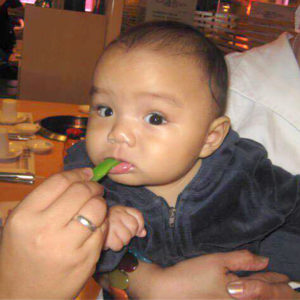
Having toddlers at home requires a lot of patience and persistence when it comes to instilling healthy eating habits. Some children at this age are finicky and it is difficult to encourage them to adapt healthy eating which will affect the development of their body as they grow. Deprivation of necessary food nutrients can lead to certain diseases that can cause ill health, poor growth, and delayed development.

Dr. Lorna’s grandson tasting boiled beans.
Here are tips on how to introduce healthy eating habits to children:
1) Mothers should breastfeed their newborn for at least six months. This is done so that babies will acquire the necessary food nutrients needed for growth and development. Breastmilk is best for babies.
2) Good eating habits can be developed while children are very young. Solid foods should be introduced one at a time. Don’t introduce solid food earlier than six months or later than seven months. Mothers can start by giving a teaspoon or two of lugaw or any vegetable or fruit puree, one kind at a time, and gradually increase the amount of food being served after the baby is accustomed to the taste, and no ill effects are noted. Foods like lugaw or mashed boiled squash or mashed banana or soup of strained mashed monggo can be tried and given once a day preferably during lunch time.
3) Young children should not be given food that has no nutritional values like candy, chocolates, and soda. Instead, encourage them to eat food like vegetables, fruits, and root crops. Giving them food with poor nutritional value can lead to obesity or weight loss and malnutrition. There are times when we allow our children to eat unhealthy food, like sweets and soft drinks offered to them at parties, provided they eat the healthy foods first. When they are full, they will consume only a little of the unhealthy food.
5) Proper timing of food intake should be observed. Set the time when they should eat breakfast, lunch, dinner and snacks. If you don’t do this, it will cause confusion to the children and will lead to loss of appetite. Our kids started to join us at mealtime when they turned 2 years old.
6) Make food presentation appealing to the child. It should taste palatable, neither bitter nor sour, neither salty nor sweet.
7) Set the example of good eating habits for your children. Our kids were accustomed to the food we prepared, and they’d see us eat the same food we served them, so it wasn’t much of a problem to get them to eat. We also allowed them to help in gathering or preparing vegetables and then they were excited to eat them.
The effect of starting children to eat the right food, with the right proportions and at the right time, will be evident throughout their lifetimes.




